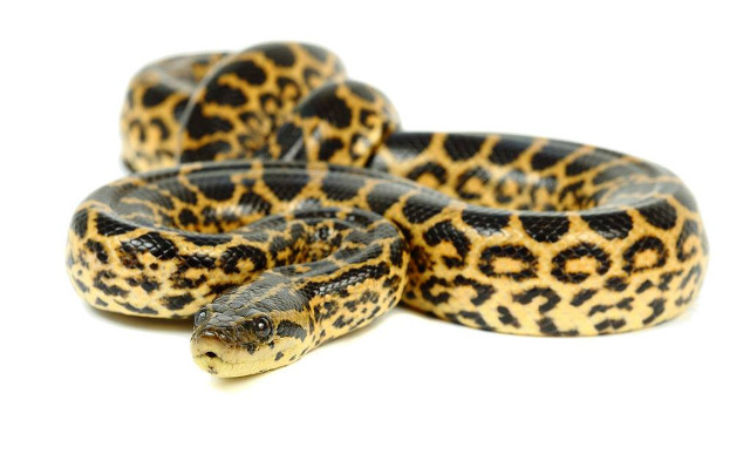What is the Average Size of a Yellow Anaconda?: Ever ponder the scale of the magnificent Yellow Anaconda as it navigates the intricate world of serpent sizes? Come along as we explore the complexities of Yellow Anacondas’ typical size and reveal the secrets that make them genuinely extraordinary as we go into the core of this sly mystery.
Into the Yellow Anaconda Realm
There is a lot of mystery and curiosity in the realm of yellow anacondas. As we explore this area, we get interested in one of the most intriguing features: their average size. What is the size of these serpents, and what is the difference between them and their larger relatives the Green Anacondas?
1. The Chronicles of the Tape Measure: Interpreting Average Lengths
With an average length of 8 to 12 feet, yellow anacondas are well-known for their grace and beauty. This results in a varied pattern of sizes within the Anaconda family, with some being marginally smaller than their Green Anaconda relatives. The poetry of the serpents that unfolds in their natural home is enhanced by every foot of their length.
2. Hues of Difference: Comprehending Size Dynamics
While shades of variety paint the world of Yellow Anacondas, an average length establishes a baseline. Some people might be taller than twelve feet, which would highlight how dynamic their sizes are. The species diversity adds a level of intricacy and serves as a reminder that rigorous measures are rarely followed in nature.
3. Involved Factors: Exposing the Size of Influencers
What elements affect the range of sizes in yellow anacondas? A combination of nutrition, environment, and heredity may hold the key to the solution. The combination of genetic predispositions, easy access to prey, and ideal habitats all contribute to the growth of these serpents, resulting in a beautiful dance between the forces of nature and their inherent potential.
4. Visual Metaphor: A Comparison of Green and Yellow Anacondas
To appreciate the subtleties of Yellow Anaconda sizes, allows me to engage in a metaphor. Imagine the Yellow Anaconda to be the expressive poet, its modest stature akin to a skillfully composed poem. The bigger sister, the Green Anaconda, on the other hand, expands like an epic poem and draws attention with its majesty. That being said, both add to the sly brilliance that is the Anaconda family.

Examining the Mysterious Stature of the Yellow Anaconda
Let’s peel back the layers of Yellow Anaconda life and embrace the beauty of their sizes against the backdrop of the rich ecosystems they call home as we continue to investigate their mysterious stature.
1. The Grace of Measurements: Comprehending the Human Form
Beyond just their stature, Yellow Anacondas have a graceful body type that adds to their overall appearance. They are the perfect example of serpentine elegance because of their powerful yet slender frame, which enables them to navigate between water and land with grace. Their life is fundamentally shaped by this combination of size and structure.
2. Beyond Quantities: Size’s Ecological Significance
Size is more than simply a number; it’s essential to the ecological dance of yellow anacondas. Their average size balances energy consumption, reproductive techniques, and predation in the ecological niches they occupy. Their perfectly balanced equilibrium is a result of millennia of evolutionary adaptations that have sculpted their sizes.
3. Human Interactions: The Significance of Dimension
Knowing the average size of Yellow Anacondas is important for people who share areas with them. It makes conservation and civilized cohabitation possible. The more peaceful coexistence of Yellow Anacondas and the communities that cross their habitats is facilitated by their more controllable size as compared to larger relatives.
4. Conservation Aspects: Maintaining Diversity in Size
Recognizing and protecting the size diversity of Yellow Anacondas is critical in the field of conservation. Maintaining the delicate balance that determines their sizes depends on several factors, including minimizing human effect, ensuring sustainable environmental practices, and protecting the ecosystems that support their natural growth. Protecting the serpentine legacy requires teamwork.
5. Using Size as a Symbol: Getting Around the Cultural Terrain
In addition to biological relevance, the Yellow Anaconda size has symbolic meaning in different cultural contexts. Native American mythology and beliefs frequently use these serpents as metaphors for fertility, metamorphosis, or even caution. Understanding the intricately linked cultural milieu that contributes an additional dimension to the multifaceted significance of Yellow Anacondas.
Conclusion: A Serpentine Legacy
To sum up, the average size of Yellow Anacondas is more than just a figure; it holds the secret to understanding the legacy of the serpentine species that they bear. Size influences the story of these amazing animals, from the gracefulness of their proportions to the ecological dance they engage in. Their perfectly balanced equilibrium is a result of millennia of evolutionary adaptations that have sculpted their sizes. Let us proceed with caution as we delve deeper into the subtleties of their existence, honoring the serpentine qualities that add to the enduring story of Yellow Anacondas in the natural world.
I hope you like the part where we talked about What is the Average Size of a Yellow Anaconda? For more content like this, visit our website reptilein.com.

